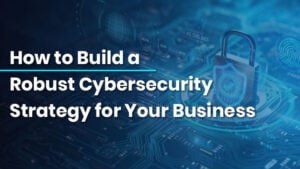
Managed vs. In-House IT: What’s Right for Your Business?
Managed vs. In-House IT: What’s Right for Your Business? Introduction Technology is no longer a support function but a key enabler of innovation, scalability, and
🔥 Limited Time Offer 🔥 Get the Premium Monthly Plan for just $11.99 $19.99. Use code UPSKILLNOW and unlock exclusive benefits 👉Subscribe Now!

Managed vs. In-House IT: What’s Right for Your Business? Introduction Technology is no longer a support function but a key enabler of innovation, scalability, and

Google Workspace vs. Microsoft 365: Which is Better for Your Team? Introduction Choosing the right productivity suite is essential for any business aiming to

How to Build a Robust Cybersecurity Strategy for Your Business Introduction In the modern digital landscape, cybersecurity is no longer just an IT concern,
Table of Contents
In an era where cyber threats are more sophisticated and prevalent than ever, developing a robust IT security strategy is crucial for safeguarding an organization’s digital assets. A well-crafted IT security plan not only protects against potential threats but also ensures regulatory compliance and reinforces trust with stakeholders. Here’s what you need to know to create an effective IT security strategy.
Elevate your organization’s IT security with expert guidance from IPSpecialist. Visit IPSpecialist today to discover how our expert-led services and training programs can enhance your security posture and ensure your digital assets are well protected.
A cybersecurity strategy is a comprehensive plan designed to protect an organization’s information systems from cyber threats. It encompasses policies, procedures, and technologies aimed at defending against unauthorized access, data breaches, and other malicious activities. This strategy involves:
A well-defined cybersecurity strategy aligns with your organization’s business goals and ensures a proactive approach to managing and mitigating cyber risks.
Cybersecurity attacks can have severe consequences for businesses, affecting various aspects of operations and reputation:
The cybersecurity landscape is constantly evolving. Stay ahead of the curve by considering these emerging trends:
The foundation of any effective IT security strategy is a thorough understanding of what needs protection. Start by identifying and cataloging all your critical assets, including:
Once you have a comprehensive inventory, assess the risks associated with these assets. This involves identifying potential threats (e.g., malware, insider threats, natural disasters) and evaluating vulnerabilities (e.g., outdated software, misconfigured systems). Risk assessment helps prioritize your security measures based on the potential impact and likelihood of various threats.
Clearly define your security objectives, which should align with your organization’s overall business goals. Objectives might include protecting customer data, ensuring system availability, or maintaining compliance with industry regulations.
Develop comprehensive security policies that outline how your organization will meet these objectives. Policies should address:
With objectives and policies in place, it’s time to implement security controls. These controls should be multi-layered and include:
Ensure that your security measures are scalable and adaptable to evolving threats. Regular updates and patches are essential to maintain the effectiveness of your defenses.
No security strategy is complete without a plan for dealing with incidents. An incident response plan should outline:
Regularly test and update your incident response plan to ensure its effectiveness.
Continuous monitoring is essential for identifying potential threats and vulnerabilities in real-time. Implement security monitoring tools to track network traffic, system logs, and user behavior.
Regularly review and update your IT security strategy to address new threats, technological changes, and evolving business needs. Conduct periodic security assessments and audits to ensure compliance with policies and identify areas for improvement.
Security is not just the responsibility of the IT department; it’s a company-wide concern. Foster a culture of security awareness by:
Consider partnering with cybersecurity experts or consultants to bolster your IT security strategy. External professionals can provide valuable insights, conduct in-depth security assessments, and offer guidance on best practices.
Creating an effective IT security strategy is essential for protecting your organization from the growing array of cyber threats. By understanding your assets and risks, defining clear security objectives, implementing strong security measures, and continuously monitoring your security posture, you can build a robust defense against potential attacks.
The first step is to understand and inventory your critical assets, including hardware, software, and data. Assess the associated risks to prioritize security measures effectively.
Your IT security strategy should be reviewed and updated regularly, at least annually, or whenever there are significant changes in your IT environment, business processes, or emerging threats.
An incident response plan should include procedures for identifying, containing, eradicating, and recovering from security incidents, as well as a process for analyzing the incident and improving future responses.
Provide regular security training, share information about current threats and best practices, and establish clear channels for reporting security concerns.
Continuous monitoring helps detect potential threats and vulnerabilities in real-time, allowing for prompt action to prevent or mitigate damage.
© 2025 All rights reserved | Privacy Policy | Terms and Conditions | Sitemap | Cookie Policy




